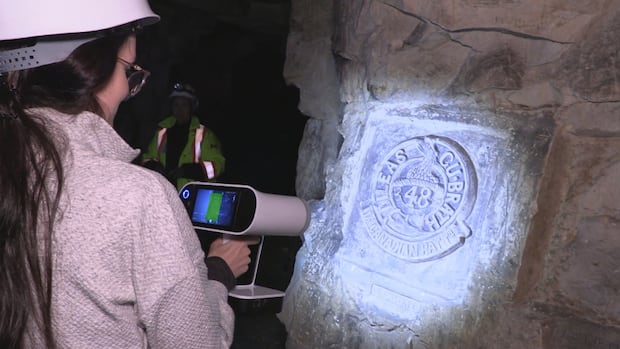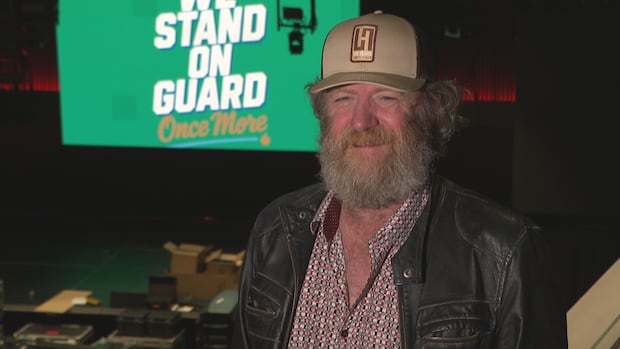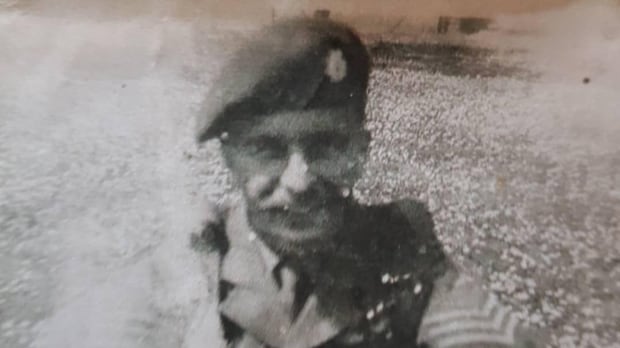With hands clutching an orange rope, we descended into the Earth, down a lengthy set of stairs and ducking our heads to avoid the low ceiling made of stone.
Now 40 feet below ground, we came to stand at the bottom of a chalk quarry called Maison Blanche souterrain.
The site is located in northern France. We were walking in the same space where hundreds of Canadian soldiers ate, slept, and in their waking hours carved and scratched images and names into the available canvas, the soft chalk walls, during the First World War.
For years, a group of dedicated volunteers from Canadigm and U.K.-based Durand Group has been heading to this quarry to document the markings left by Canadians more than a century ago. I joined them during one such excursion in October.
By late 1916, the quarry was the home to units of the 1st Division’s 3rd Canadian Infantry Brigade, which included the 15th Battalion, 48th Highlanders. They were there in the lead up to the Battle of Vimy Ridge.
Many of the intricate carvings in the walls, illuminated by my handheld light, were for cap badges. Others depicted female faces, animals, and a face that resembled Norwegian artist Edvard Munch’s The Scream.
On the ground was a bit of refuse left behind, including a trench periscope and bottles. I was told a few bullets and grenades had also been found inside the winding cave.
But my time there wasn’t as a CBC reporter. It was just a vacation in Belgium with my dad that had taken an unexpected turn after we met some of the volunteers documenting the site while in Ypres waiting for the Menin Gate Last Post ceremony.
We got to chatting about why we were there, and after I nearly sprained my ankle, an invitation was extended to visit them at their worksite across the border in France.
Durand Group volunteer David Hedges led us through the cave, telling us stories about the men who lived there for a time. For some, it was the last place they lived before dying in battle.
One carving was a mailbox where soldiers, prior to a battle, could write a letter to be sent to their loved ones. If they survived, they removed the letter so that it wasn’t sent.
‘Travelling in the footsteps’
After I returned home to St. John’s, I contacted Canadigm and the Durand Group to learn more about their work.
Canadigm’s artistic and executive director Zenon Andrusyszyn said their members are volunteers who help document historical artifacts and sites. One of those sites has been Maison Blanche souterrain, located a short distance from the Vimy Ridge National Historic Site.
“If you’ve got a light, then you basically see walls, and if you look closer and inspect them carefully, then you start seeing the names of the Canadian soldiers,” Andrusyszyn said during a Zoom call from London, Ont.
“It’s a humbling experience to go down there, knowing that … we were travelling in the footsteps of the Canadian soldiers,” he said.
Andrusyszyn said the cave’s temperature is consistently cool and easily could house about 200 men.
Some of the carvings have dates, even dated just a few weeks before the Battle of Vimy Ridge, which started April 9, 1917, Andrusyszyn said.
The group has researched the lives of these soldiers and found some survived the war and others did not.
“The graphics that they left on the walls sort of opened a window into the mindset at the time they were down there,” he said.
He pointed to one man named Earl Laroy Lacey of Dutton, Ont., who carved various animals onto the walls, like a pig and swan, which were his farm animals back home.
“He’s thinking about home,” said Andrusyszyn.
Lacey didn’t survive the war to return to his animals.
Norman Allatt, a sniper, drew a sketch of his girlfriend. Andrusyszyn said they found the man went on to marry his girlfriend when they reached out to the soldier’s family.
Another story discovered was of William Thomas Harvey and Clarence Otto Harvey, brothers from McKellar, Ont. who enlisted together. The older brother vowed to stick by Clarence throughout the war and keep him safe, even turning down a promotion that would have separated them. Clarence never made it home.
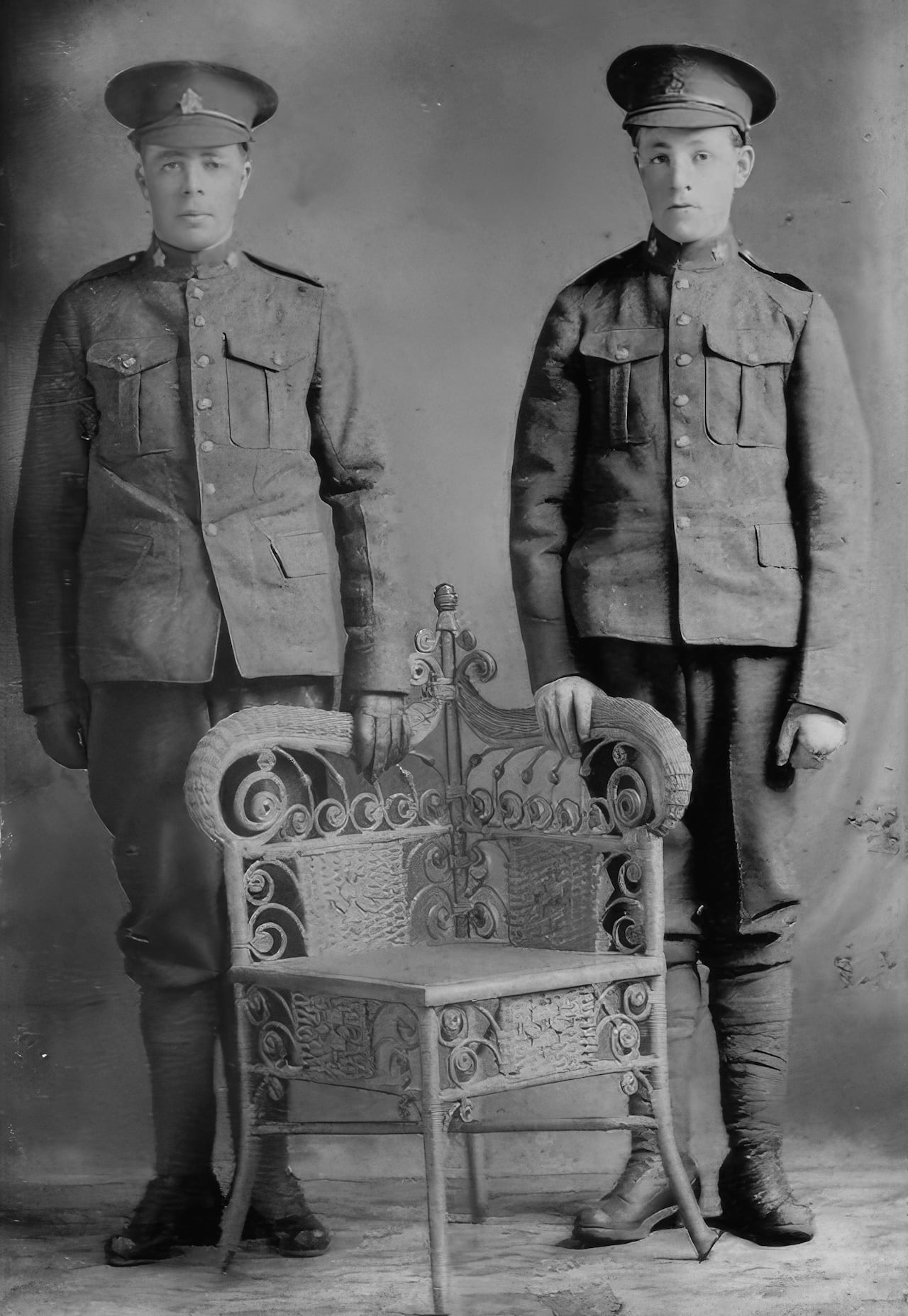
Other carvings include the cap badges, as the soldiers proudly represented the units they were serving with.
Andrusyszyn said the group has been going into the quarry for years now, but there is still plenty of work left to be done. For instance, he said, when they started over a decade ago the technology to scan the walls wasn’t as advanced as today.
New 3D scanners can pick up pencil sketches soldiers made on the walls, drawn out with the standard-issued purple pencil they were given.
I had the opportunity to try the heavy 3D device, and learned the patience it took to scan a single carving.
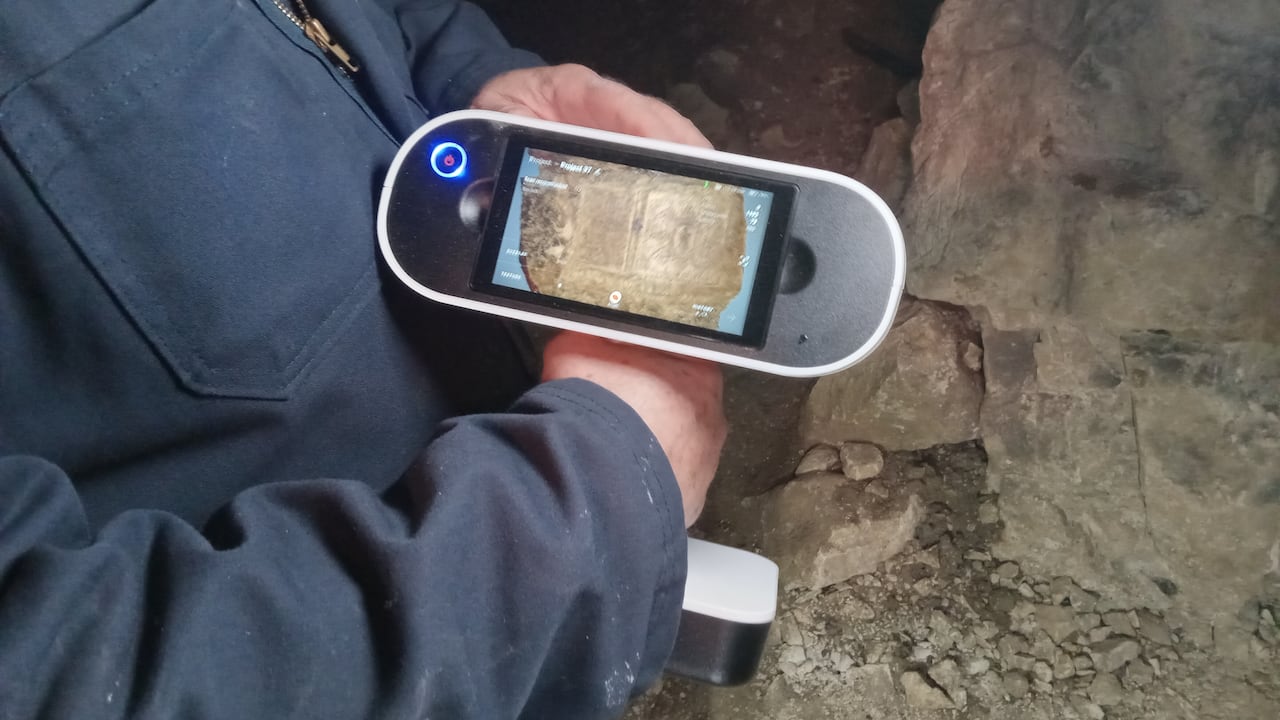
Re-discovery buried in garbage
The Durand Group, made up of about 30 volunteers, has experience with bomb disposal, archaeology and consists of historians and others.
As a member, David Hedges has spent a fair amount of time in historic tunnels and caves.
Centuries ago, Hedges said those who lived in the area dug into the chalk below ground to create a quarry for building materials, and later it became a hiding spot in times of conflict.
Hedges said soldiers thought being below ground in the souterraines was safer than being above ground because they could avoid artillery.
More than a century ago, Canadian soldiers fighting in the First World War used an underground quarry as barracks and left behind carvings and sketches on the walls. The CBC’s Elizabeth Whitten got a look at the ongoing preservation work.
After the war, Maison Blanche souterrain was visited by tourists, but in the mid-20th century it became a dumping group for garbage and was forgotten about, only to be re-discovered in 2006.
When Hedges first visited, he said he had to scramble above the garbage to get inside.
“We eventually got clear of the garbage and we could stand up. And then we found the most magnificent cave that’s ever been found on the Western Front,” Hedges said, sitting in his home in Felixstowe, England.
Beyond the detailed carvings, he said some 750 soldiers put their names on the walls.
“Its by far the richest cave that’s ever been found and particularly poignant for the Canadians,” said Hedges.
He said Maison Blanche souterrain isn’t open to the public, due in part to safety concerns but the Durand Group does bring in historians and families who have ties to the soldiers who left those carvings.
“It is a great experience to bring families back and stand where their own relative was in the First World War,” Hedges said. “Unfortunately, some of them died. Others survived and it is nice to show particularly Canadian groups around.”

Hedges said Durand Group has been cleaning up the site, but there are still bags of detritus about. As a result, they are still finding new carvings to document.
For example, Andrusyszyn said, one chamber previously blocked off had names sketched on the wall only visible when hit by light at a 45-degree angle.
The day we visited, one of the Canadigm members had a new discovery to share. They had found a section where someone carved “April 9 Grand Advance” into a wall, noting a great battle was coming up.
Whoever wrote that into the wall was marking the commencement of the Battle of Vimy Ridge.
Andrusyszyn said they knew particular soldiers were in the cave of April 8, and their carvings might be the last thing they did.
Around the cave, Vimy Ridge has been carved as a battle honour, which Hedges said is significant as it’s likely the first time it was recorded on the wall and happened shortly after the battle.
“Therefore they are extremely valuable, not that we’d ever try and take them out,” said Hedges.
On my trip we did see chunks of carvings that had been at some point in the past removed.
‘The fate of all souterrains’
I began to wonder about how firm the roof was. It’s something those documenting the cave think about too.
In some places, Hedges said, there is only a metre of ground between
the cave and the surface, adding there are cases of homes falling into souterraines all over France. He said Maison Blanche souterrain hasn’t had a collapse in 100 years, but it is a matter of when it happens again, not if.
“Eventually it will collapse, as is the fate of all souterraines,” he said. “It is very important that we fully record what is there … in the worst case it does start deteriorating badly.”
Andrusyszyn said putting a name and a face to these carvings makes it personal, creating a connection to the past. But there’s another pressing need to record these carvings.
“There’s no guarantee that that cave is going to last another 100 years,” he said.
Andrusyszyn said they don’t want to lose this site, as it’s part of Canada’s heritage.
He said the Maison Blanche souterrain project is part of a larger project, and one day he’d like to create a website where people can see the soldiers’ names, look at sculptures and research the individuals.
He said beyond Vimy, they want to look at the entire Western Front, looking for names on the sides of buildings and churches.
“They are deteriorating quicker than the ones that are below ground,” said Andrusyszyn.
Download our free CBC News app to sign up for push alerts for CBC Newfoundland and Labrador. Sign up for our daily headlines newsletter here. Click here to visit our landing page.



